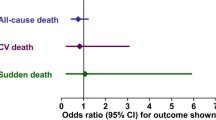Abstract
Objective
Some phosphodiesterase (PDE)-inhibitors are believed to alter platelet count and function due to changes in intracellular cAMP. Whether newly developed (specific) PDE-inhibitors negatively influence platelet function in cardiac surgery should be investigated in a randomized study.
Methods
Eighty patients undergoing aorto-coronary bypass grafting were divided into 4 groups and received either the new PDE-III-inhibitor piroximone (group 1), the PDE-III-inhibitor enoximone (group 2), epinephrine (group 3) or no inotropic support (control). PDE-III-inhibitors were given as a bolus followed by infusion until starting of cardiopulmonary bypass (CPB). In addition to platelet count and a thrombelastogram, platelet function was assessed by aggregometry (ADP, epinephrine, collagen). Measurements were done before, during and after CPB until the 1st postoperative day.
Results
Platelet count and postoperative blood loss did not differ between the groups within the entire investigation period. Maximum aggregation and maximum gradient of platelet aggregation to all stimuli were not changed by either PDE-inhibitor enoximone or piroximone. CPB resulted in a significant decrease of all aggregation variables which was without differences due to treatment. Platelet aggregation recovered in the post-bypass period and exceeded baseline values on the 1st postoperative day.
Conclusion
It is concluded that enoximone and the new PDE-III-inhibitor piroximone do not affect platelet function and can be used before CPB without risking plateletrelated bleeding in cardiosurgical patients in the perioperative period.
Similar content being viewed by others
Change history
16 June 2023
This article has been retracted. Please see the Retraction Notice for more detail: https://doi.org/10.1007/s00134-023-07132-6
References
Harker LA (1986) Bleeding after cardiopulmonary bypass. N Engl J Med 314:1446–1447
Bick RL (1985) Hemostatic defects associated with cardiac surgery, prosthetic devices, and other extracorporeal circuits. Semin Thromb Hemostat 3:249–280
Young JA (1983) Coagulation abnormalities with cardiopulmonary bypass. In: Utley JR (ed) Pathophysiology of cardiopulmonary bypass, vol II. William & Wilkins, Baltimore, pp 88–105
Harker LA, Malpass TW, Branson HE, Hessell EA, Slighter SJ (1980) Mechanism of abnormal bleeding in patients undergoing cardiopulmonary bypass. Blood 56:824–834
Breisblatt WM, Stein KL, Wolfe CJ (1990) Acute myocardial dysfunction and recovery: a common occurrence after coronary bypass surgery. J Am Coll Cardiol 15:1261–1269
Colucci WS, Wright RF, Braunwald E (1986) New positive inotropic agents in the treatment of congestive heart failure. First Part. N Engl J Med 314:290–299
Artman M, Kithas PA, Wike JS, Crump DB, Strada SJ (1989) Inotropic responses to cyclic nucleotide phosphodiesterase inhibitors in immature and adult rabbit myocardium. J Cardiovasc Pharmacol 13:146–154
Axelrod RJ, De Marco T, Dae M, Botvinick EH, Chatterjee K (1987) Hemodynamic and clinical evaluation of piroximone, a new inotrope-vasodilator agent, in severe congestive heart failure. J Am Coll Cardiol 9:1124–113
Rutman HI, LeJemtel TH, Sonnenblick EH (1987) Newer cardiotonic agents: implications for patients with heart failure and ischemic heart disease. J Cardiother Anesth 1:59–70
Campbell FW, Addonizio Jr VP (1988) Platelet function alterations during cardiac surgery. In: Ellison N, Jobes DR (eds) Effective hemostasis in cardiac surgery. Saunders, Philadelphia, pp 85–109
Günnicker M, Hess W (1987) Preliminary results with amrinome in perioperative low cardiac output syndrome. Thorac Cardiovasc Surgeon 35:219–224
Born GVR (1962) Aggregation of blood platelets by adenosine diphosphate and its reversal. Nature 194:927–929
Hines R (1989) Infusion of sodium nitroprusside induces platelet dysfunction in vitro. Anesthesiology 70:611–615
Addorizio VP, Coleman RW (1980) Platelets and extracorporeal circulation. Biomaterials 56:9–15
Wenger RK, Lukasiewics H, Mikuta BS, Niewiarowski S, Edmunds LH (1989) Loss of platelet fibrinogen receptors during clinical cardiopulmonary bypass. J Thorac Cardiovasc Surg 97:235–239
Gerrard JM, Peller JD, Krick TP, White JG (1977) Cyclic AMP and platelet prostaglandin synthesis. Prostaglandins 14:39–50
Kaser-Glanzmann R, Jakabova M, George JN, Luscher EF (1977) Stimulation of calcium uptake in platelet membrane vesicles by adenosine, 3′,5′-cyclic monophosphate and protein kinase. Biochem Biophys Acta 466:429–440
Coppe D, Sobel M, Seamans L, Levine F, Salzman E (1981) Preservation of platelet function and number by prostacyclin during cardiopulmonary bypass. J Thorac Cardiovasc Surg 81:275–278
Horch U, Kadatz R, Kopitar Z, Weisenberger H (1970) Pharmacology of dipyridamole and its derivatives. Thromb Diath Haemorrh 42 [Suppl]:253
Raja SM, Penny AF, Crow MJ (1979) The action of varying doses of dipyridamole and acetyl salicylic acid on the inhibition of platelet functions and their effect on bleeding time. Br J Clin Pharmacol 8:483–489
Chesebro JH, Clements IP, Fuster V, Elveback LR, Smith HC, Bardsley WT, Frye RL (1982) A platelet-inhibitor drug trial in coronary-artery bypass operations: benefit of perioperative dipyridamole and aspirin therapy on early postoperative vein-graft patency. N Engl J Med 307:73–78
Ansell J, Tiarks C, McCue J, Parilla N, Benotti JR (1984) Amrinone-induced thrombocytopenia. Arch Intern Med 144:949–952
MacGillivray RG, Shama DM (1988) Amrinone, platelets, and the ballon pump. J Cardiothorac Anesth 2:268–270
Bowie EJW, Owen CA (1984) The clinical and laboratory diagnosis of hemorrhagic disorders. In: Mishler PA (ed) Disorders of hemostasis. Grune and Stratton, Orlando, pp 43–72
Sircar I, Steffen RP, Bobowski G, Burke SE, Newton RS, Weishaar RE, Bristol JA, Evans DB (1989) Cardiotonic agents. 9. Synthesis and biologic evaluation of a series of (E)-4,5 Dihydro-6-[2-[4-(1 Himidazole-1-yl]phenyl]-3(2H)-pyridzinones: a novel class of compounds with positive inotropic, antithrombotic, and vasodilatory activities for the treatment of congestive heart failure. J Med Chem 32:342–350
Herzig JW, Rügg JC, Solaro RJ (1990) Myocardial excitation-contraction coupling as influenced through modulation of the calcium senstivity of the contractile proteins. Heart Failure 6:244–250
Mammen EF, Koets MH, Washington BC (1985) Hemostasis changes during cardiopulmonary bypass surgery. Semin Thromb Hemostat 11:281–292
Holloway DS, Summaria L, Sandesara J, Vagher JP, Alexander JC, Caprini JA (1988) Decreased platelet number and function and increased fibrinolysis contribute to postoperative bleeding in cardiopulmonary bypass patients. Thromb Haemostat 59:62–67
Friedenberg WR, Myers WO, Plotka ED, Beathard JN, Kummer DJ, Gatlin PF, Stoiber D, Ray JF, Sautter RD (1978) Platelet dysfunction associated with cardiopulmonary bypass. Ann Thorac Surg 25:298–305
Author information
Authors and Affiliations
About this article
Cite this article
Boldt, J., Knothe, C., Zickmann, B. et al. RETRACTED ARTICLE: Phosphodiesterase-inhibitors enoximone and piroximone in cardiac surgery: Influence on platelet count and function. Intensive Care Med 18, 449–454 (1992). https://doi.org/10.1007/BF01708579
Received:
Accepted:
Published:
Issue Date:
DOI: https://doi.org/10.1007/BF01708579




